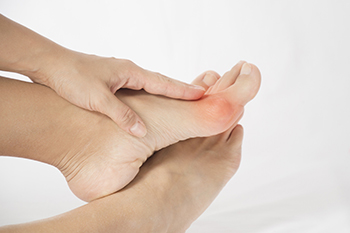159 North 3rd Street
Macclenny, Florida 32063

A bunion, or hallux valgus, is when a bony bump occurs on the joint of the big toe. This happens when a few of the bones on the top part of the feet move out of place. As a result of prolonged pressure, the tip of the big toe is pulled toward the smaller toes and forces the joint of the big toe to remain stuck. The skin above the bunion may get red and sore, and calluses might form where the shoe rubs against it. Wearing narrow, tight shoes or standing for a prolonged time might contribute to this condition and make it worse. Bunions can also form from one’s foot shape, a medical problem, such as arthritis, or a foot deformity. Wearing better-fitting shoes, obtaining bunion pads, or using toe spacers might help, and if not, a surgery called a bunionectomy can be performed. The elderly and women are most apt to suffer from this problem. If you have a bunion, consult with a podiatrist who can confirm the diagnosis and suggest the best treatment options for you.
If you are suffering from bunions, contact Dr. John L. Coleman of Florida. Our doctor can provide the care you need to keep you pain-free and on your feet.
What Is a Bunion?
A bunion is formed of swollen tissue or an enlargement of boney growth, usually located at the base joint of the toe that connects to the foot. The swelling occurs due to the bones in the big toe shifting inward, which impacts the other toes of the foot. This causes the area around the base of the big toe to become inflamed and painful.
Why Do Bunions Form?
Genetics – Susceptibility to bunions are often hereditary
Stress on the feet – Poorly fitted and uncomfortable footwear that places stress on feet, such as heels, can worsen existing bunions
How Are Bunions Diagnosed?
Doctors often perform two tests – blood tests and x-rays – when trying to diagnose bunions, especially in the early stages of development. Blood tests help determine if the foot pain is being caused by something else, such as arthritis, while x-rays provide a clear picture of your bone structure to your doctor.
How Are Bunions Treated?
If you have any questions, please feel free to contact our office located in Macclenny, FL . We offer the newest diagnostic and treatment technologies for all your foot care needs.